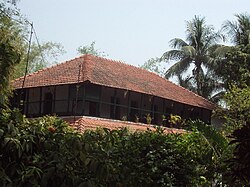Sarat Chandra Kuthi: Difference between revisions
Tamravidhir (talk | contribs) ←Created page with '{{Infobox building |name = Sarat Chandra Kuthi | native_name = <big>শরত্চন্দ্র কুঠী</big> |image = Samta - Sarat...' |
(No difference)
|
Revision as of 16:03, 20 March 2012
| Sarat Chandra Kuthi | |
|---|---|
শরত্চন্দ্র কুঠী | |
 The house of Sarat Chandra Chattopadhyay popularly known as "Sarat Chandra Kuthi". | |
 |

Sarat Chandra was born into poverty in Debanandapur, Hooghly, West Bengal in India but he spent the early years of his lifetime as a novelist here in Samta. His house in Samta is often called by and shown as "Sarat Chandra Kuthi" (Bengali: শরত্চন্দ্র কুঠী) in the map of Samta in Howrah, West Bengal. He used to live in Samta and stay in his house with the fishermen and washer men. So the villagers separated him from the village, as fishermen and washer men were considered to be of low caste. So he along with the houses where he lived with the fishermen and washer men, used to call as a separate village called "Samtaber".

The Rupnarayan River then used to flow right outside the window of Sarat Chandra’s ground floor study. Now, the river has changed its route and has moved far away. The author would often gaze at the sparkling river while writing Abhagir Swarga, Kamal Lata, Shesh Prashna, Palli Samaj, Ramer Sumati, Pather Dabi and Mahesh. The two storied Burmese style house was also home to Sarat Chandra. His along with his brother Swami Vedananda's samadhi can still be seen there. Swami Vedananda was a disciple in Belur Math. The trees like that of bamboo, galoncho and the guava trees planted by the renowned author are still tourist attractions[1].


Parts of the house-like the mud-walled kitchen-collapsed and the house was damaged in the 1978 floods, the Zilla Parishad undertook its repair spending ₹77000. After it was declared as a Heritage or Historical Site by the Clause 2 of the West Bengal Heritage Commission Act 2001 (Act IX of 2001)[2][3] in 2009 the whole house was renovated and the belongings of Sarat Chandra like his furniture, walking stick, shoes etc. were polished and are restored in showcases. The tress which was almost going to fall down and die was given proper care and support. The house’s boundary has been extended till the Samadhis, surrounding them which earlier used to lie on the road. Except these tress have been planted around the house which add to its beauty.
Opposite to the house there is also a pond, which he mentioned in his novel Palli Samaj; he mentioned about two fishes of the pond,-who lived there-as Kartika and Ganesh, in the novel.
